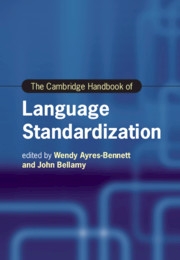Book contents
- The Cambridge Handbook of Language Standardization
- cambridge handbooks in language and linguistics
- The Cambridge Handbook of Language Standardization
- Copyright page
- Contents
- Figures
- Tables
- Contributors
- Introduction
- Part I Revisiting Models and Theories of Language Standardization
- Part II Legitimacy, Authority and the Written Form
- Part III Norms, Literacy and Education
- Part IV Beyond the National
- Part V Standardization in Late Modernity
- 25 Destandardization
- 26 Contemporary Perspectives on Language Standardization
- 27 Standardization and New Urban Vernaculars
- 28 Renegotiating Language Norms in Minority Contexts
- 29 Sign Language Standardization
- Name Index
- Subject Index
- References
25 - Destandardization
from Part V - Standardization in Late Modernity
Published online by Cambridge University Press: 01 July 2021
- The Cambridge Handbook of Language Standardization
- cambridge handbooks in language and linguistics
- The Cambridge Handbook of Language Standardization
- Copyright page
- Contents
- Figures
- Tables
- Contributors
- Introduction
- Part I Revisiting Models and Theories of Language Standardization
- Part II Legitimacy, Authority and the Written Form
- Part III Norms, Literacy and Education
- Part IV Beyond the National
- Part V Standardization in Late Modernity
- 25 Destandardization
- 26 Contemporary Perspectives on Language Standardization
- 27 Standardization and New Urban Vernaculars
- 28 Renegotiating Language Norms in Minority Contexts
- 29 Sign Language Standardization
- Name Index
- Subject Index
- References
Summary
If language standardization is understood as a historical process that strengthens a standard norm at the expense of variation, prefixing de- to standardization gives us a notion concerning change in the opposite direction: a progressive weakening of the norm in favour of variation. This is what the chapter discusses: are we experiencing, under the contemporary conditions of Late Modernity, a situation whereby the continued strengthening of the standard norm is being replaced by an incipient weakening? It is argued that the discussion needs to focus on the ideological aspect of the issue. Norway is discussed as an exemplary case of norm weakening, based on evidence that the multiplicity of dialects is more present and accepted in public domains than ever before, as the standard language ideology (tSLI; he belief in a ‘best’ language) has been abandoned: destandardization. In contrast, Denmark is discussed as an exemplary case of continued norm strengthening based on evidence that dialectal variation disappears as SLI changes, but grows stronger than ever before. This latter situation is termed demotization. Other terms are also discussed, including restandardization and vernacularization, which have been proposed in reported work from other countries (including Germany, Italy, The Netherlands, the UK, the USA, New Zealand and Sri Lanka).
Keywords
- Type
- Chapter
- Information
- The Cambridge Handbook of Language Standardization , pp. 667 - 690Publisher: Cambridge University PressPrint publication year: 2021
References
- 2
- Cited by



